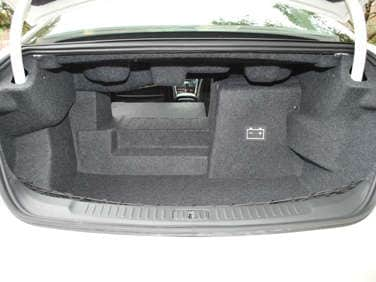Recent Articles
Popular Makes
Body Types
2013 Chevrolet Malibu Eco First Drive Review
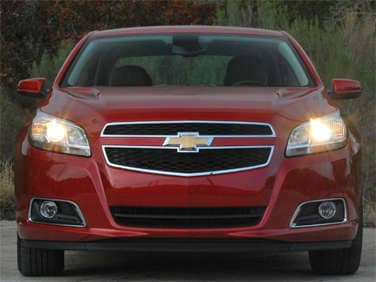
For years, Toyota and Honda ruled the mid-size segment with their proven, appliance-like offerings, but, more recently, this market has been infused with a sportier spirit making the cars more stylish, more comfortable and more fun to drive. In the Chevy stable, the redesigned 2013 Chevrolet Malibu definitely hits all of these key points, and brings back a hybrid model with the Malibu Eco. Sharing its platform with the Buick LaCrosse, it only made sense equip the 2013 Malibu Eco with GM's eAssist mild-hybrid system, and since Chevy is launching this fuel-efficient trim level first (these cars on the way to dealerships right now), we had the chance to drive the 2013 Chevrolet Malibu Eco in Austin, Texas for this first drive review. The Malibu Eco marks the return of the Malibu to the hybrid segment following the cancelation of the Malibu Hybrid in 2010.
2013 Chevrolet Malibu Eco First Drive Review: Pricing and Trim Levels
Production of the 2013 Chevrolet Malibu kicked off at GM's Fairfax Assembly Plant in Kansas City, Kansas, but when other trim levels (including the sportier LTZ model shown on this page) go on sale this summer, the Malibu will also be built at the Detroit-Hamtramck Assembly Plant. The 2013 Malibu will also be available in LS, LT and LTZ trim levels, and while specific trim level positioning isn't known at this time, the Malibu Eco will likely be positioned just under the top-of-the-line LTZ model, and it will start at $25,995 including the $760 destination charge; pricing for the other 2013 Malibu trim levels won't be announced until closer to the launch date. The specific car used for this review had a few optional features and carried an as-tested price of $29,950 which, fully loaded, is just slightly more than some base model versions of other mid-size hybrid sedans.
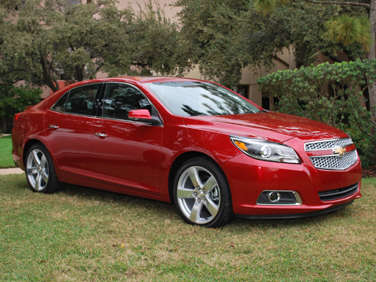
2013 Chevrolet Malibu Eco First Drive Review: Competition
When it comes to fuel-efficient mid-size sedans, the 2013 Chevrolet Malibu Eco will go head-to-head against the Toyota Camry Hybrid, Hyundai Sonata Hybrid, Kia Optima Hybrid, Ford Fusion Hybrid as well as the diesel-powered Volkswagen Passat TDI. While the Malibu Eco's fuel economy isn't as good as a full hybrid, its main advantage is a more affordable MSRP and a driving feel that is less jerky and quirky. The big test for the Malibu will be once the full line-up is on sale later this summer to see how it can keep pace in one of the highest volume segments on the market. With its 204,808 units sold in 2011, the Chevy Malibu saw an increase of 3 percent in sales over 2010 helping to make it the third-best-selling car in GM's entire U.S. portfolio after the Chevy Silverado and the Chevy Cruze.
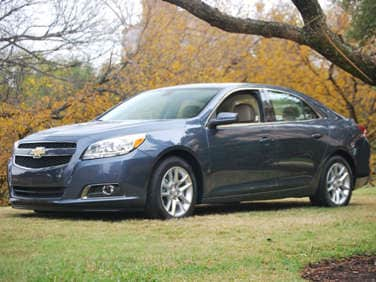
2013 Chevrolet Malibu Eco First Drive Review: Exterior
Depending on which angle from which the 2013 Chevrolet Malibu is viewed, the reception of the exterior design could completely. From the front of the car, it would take a trained eye to catch the major differences from the 2008 to 2012 Malibu design as it keeps a similar look with the diamond-shaped headlights and Chevy's signature twin-port grille, but it adds more attitude thanks to a more aggressive front fascia and sharper sculpting on the hood and fenders. Those approaching the new Malibu from the rear will get a totally different impression of the car with rectangular taillights obviously inspired by the popular fifth-generation Camaro to go with athletic rear haunches and an integrated decklid spoiler. This view is also where the Malibu Eco model is most distinguishable as it has hidden exhaust outlets. In addition to the fuel economy gains afforded by the eAssist system, the Malibu's exterior was also fine tuned in the wind tunnel (GM says for 500 hours) to produce a sleek shape that has a coefficient of drag that is just .30 (the Chevy Volt, one of GM's most aerodynamic cars ever built has a cD of .28).
This new global Malibu rides on a wheelbase that is almost five inches shorter than the current Malibu, but it only a half inch shorter in overall length. What really adds to the visual impact of this new design (as well as to the spacious interior) is the fact that the 2013 Malibu is almost three inches wider than its predecessor. In addition to its global platform, the exterior of the 2013 Malibu was designed to meet the various changes required for the 100 markets that the car will be sold in ranging from crash standards to license plate size.
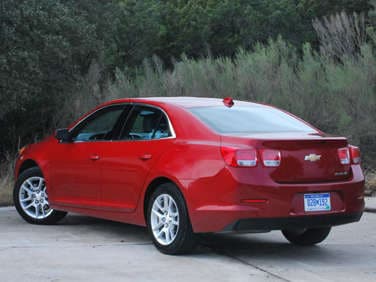
2013 Chevrolet Malibu Eco First Drive Review: Interior
The interior of the current (2008-2012) Malibu helped jumpstart Chevy in a good direction for its interiors, and this trend definitely continues on the 2013 Chevrolet Malibu with what should prove to be one of the best interiors in this class. Much like the current car, the Malibu's cabin is highlighted by the dual-brow instrument panel and a flowing, vertical center stack, and for a sportier look, the Malibu LTZ will continue to offer a two-tone interior option that features brown leather seat inserts, brown seat piping and brown accents on the instrument panel and door panels. Matching the theme of the new Malibu's taillights, the lineage to the Camaro's design are apparent with the rounded square shape of the dual gauge cluster and the equally sporty steering wheel now featured in many GM products. Other key cabin elements include the vent-like trim spans the instrument cluster, soft-touch materials throughout the cabin and, for the first time, the availability of an in-dash navigation system.
This navigation system, offered as a part of a $1,020 option package, that also adds an auto-up driver's window and memory front seats and door mirrors. Models not equipped with nav still get a large touch screen display to control the MyLink. A standard feature on all 2013 Malibu Eco models, the Chevrolet MyLink infotainment system allows the car to be paired with smartphones to utilize applications such as Pandora and Stitcher. This touch screen used for MyLink and navigation also cleverly hides a six-inch deep storage compartment that is large enough to keep small electronic devices safely out of sight. Our test vehicle was also equipped with a $1,000 leather package that includes leather seats, eight-way power passenger seat and heated front seats.
As is the case with some other hybrids, even the compact size of the Malibu Eco's battery takes up some space in the trunk. Compared to non-hybrid 2013 Malibu models, the Eco's cargo area is reduced by 2 cubic feet (offering 14.3 cu. ft. of space) and the split, folding rear bench seat only allows a partial pass-through to the passenger compartment.
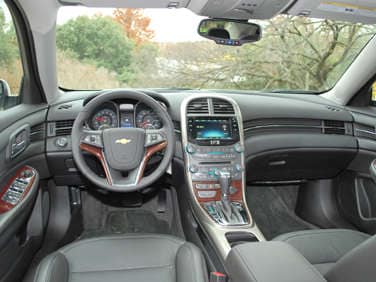
2013 Chevrolet Malibu Eco First Drive Review: Powertrain and Fuel Economy
Under the hood, the bright orange cables for the hybrid system attract most of the attention, but the big news is that the 2013 Chevrolet Malibu will get three all-new engine options. The 2013 Malibu Eco is powered by a 2.4-liter, direct-injected inline-four that produces 182 horsepower and 172 lb-ft of torque. As the highlight of the Eco model, this engine is paired with a belt-driven motor/generator that adds an additional 15 horsepower of electric assist when the engine is under heavy acceleration. The motor gets its power from a compact, 15 kW lithium-ion battery that is mounted between the rear seat and the cargo area. This mild-hybrid eAssist system allows the Malibu Eco to offer improved fuel economy without the weight and price gains of a conventional hybrid. Although the EPA has yet to post its official fuel economy estimates for the Malibu Eco, Chevy expects it to get 25 miles per gallon in the city, 37 mpg on the highway and a rating of 29 mpg in combined driving making it the most fuel-efficient Malibu ever. Down the road, the Malibu will also offer a 2.5-liter inline-four and a 2.0-liter turbo, but Chevy has yet to announce any official specs or availability for either engine. All 2013 Malibu models are equipped with the same six-speed automatic transmission that offers a manual shift mode built into the shift lever.
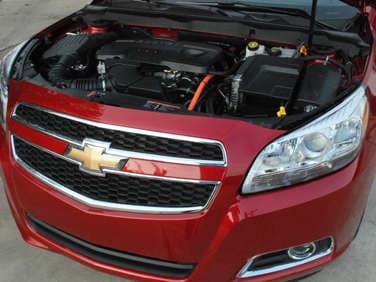
2013 Chevrolet Malibu Eco First Drive Review: Driving Impressions
Unlike other hybrids in this segment, the 2013 Chevrolet Malibu Eco is not able to drive the front wheels with electric power only, which actually means that this car doesn't suffer the same jerkiness at stops or during an electric-to-engine transition as its counterparts do. Also unnoticeable to the driver, the eAssist system shuts off the fuel supply during deceleration to further reduce the engine's consumption of fuel, and the only time the car's hybrid system can really be felt is when the Automatic Start/Stop feature shuts the engine off at long stops. Even better, the lightweight battery (weighing just 64 pounds) adds very little to the Malibu's curb weight, so the driving dynamic and handling abilities are exactly what should be expected from a mid-size sedan. During a drive route that took us through some twisty roads in Texas Hill Country, we were impressed at how responsive this new Malibu feels and how quiet the interior sounds. The Malibu's wider stance has also allowed the track to be widened substantially giving the car better stability during cornering. Chevy says that the new Malibu Eco can accelerate from zero to 60 miles per hour in around 8.7 seconds which isn't horrible for this class of car, but expect the new Malibu Turbo to get up to speed a little quicker.
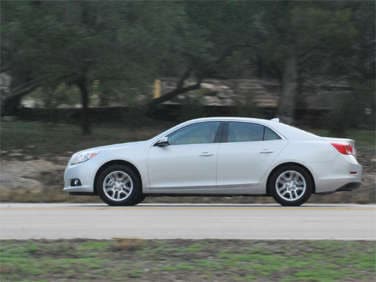
2013 Chevrolet Malibu Eco First Drive Review: Safety
Since the 2013 Chevrolet Malibu has yet to launch, the National Highway Traffic Safety Administration (NHTSA) or Insurance Institute for Highway Safety (IIHS) have not tested the new car for crash safety. Standard safety features on the new Malibu Eco include eight airbags, daytime running lights (DRL), electronic brake-force distribution with brake assist, four-wheel anti-lock disc brake system, tire pressure monitoring system (TPMS), StabiliTrak electronic stability control with traction control and, of course, GM's OnStar system. Although the Eco's airbag count stands at eight, Chevy says that the car will come standard with 10 airbags (adding rear-seat side airbags) this summer, but it isn't clear if this will be added to Eco as well as all other models.
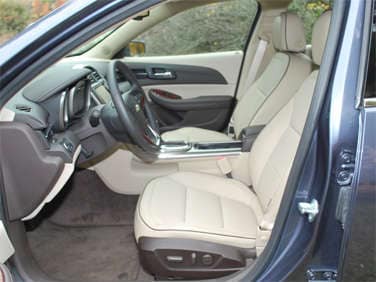
2013 Chevrolet Malibu Eco First Drive Review: Final Thoughts
Although the Chevrolet Malibu is far from the muscle car it started out as in the 1960s, the eighth-generation model still manages to inject the mid-size sedan segment with plenty of premium features and a fun-to-drive spirit... that's without even factoring in the top-of-the-line Malibu LTZ coming later this year. When all is said and done, the 2013 Chevrolet Malibu line-up should be a stark departure from the typical car in this sometimes-boring segment with its varying models offering a mix of affordability, sportiness and fuel efficiency. In regards to the latter, the Malibu Eco brings the Malibu nameplate back to the hybrid segment, but as good as it is, it will be interesting to see how it will hold up against a new Accord and a more advanced Ford Fusion (including a hybrid and a plug-in hybrid) - both of which are due out later this year - not to mention other hybrids on the market including the proven Camry and the sporty Optima. Still, in a vehicle segment that has been defined by unexciting, status quo cars over the years, the redesigned 2013 Chevrolet Malibu should continue to be a top seller in this family-centric market.
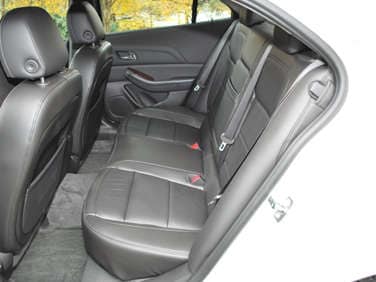
2013 Chevrolet Malibu Eco First Drive Review: Pros and Cons
- class-leading interior design and function
- low-cost eAssist mild hybrid system on Malibu Eco improves fuel economy
- turbo inline-four on non-hybrid models replaces V-6
- Malibu finally gets in-dash navigation
- Malibu Eco tech, fuel economy trails the hybrid competition
- compact battery still sacrifices some cargo space
Chevrolet provided travel, lodging and vehicle for this review. Photos by Jeffrey N. Ross
